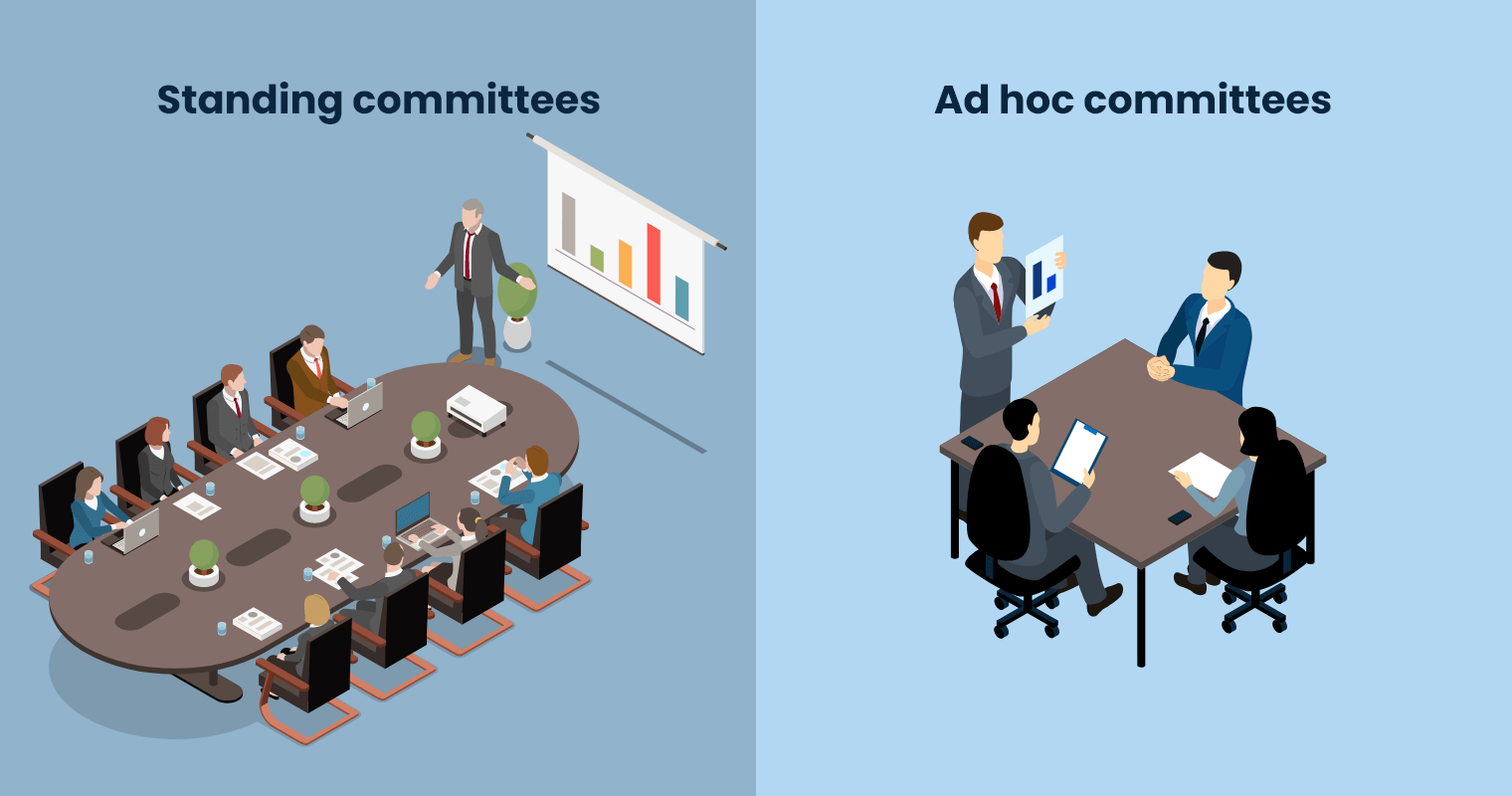“With great power comes great responsibility.” This is a famous line you probably associate with leadership and governance, or simply, boards. Boards hold both great power and responsibility over the company they’re serving. Tasked with oversight, they are responsible for checking the progress of strategies and operations. However, the boards themselves, whether for-profit or nonprofit, may also need an entity to oversee them.
This is where the governance committee comes in. Members of this committee are typically appointed to help carry out the board’s due diligence. Explore more of the governance committee’s definition and responsibilities below.
What is the governance committee?
A governance committee oversees the board of directors in their functions and duties. It ensures that directors and the rest of the committees operate accordingly through performance evaluations. It is one of the five core committees that every board must have, together with the Audit, Compliance, Risk, and Compensation committees.
The governance committee also helps the board empower corporate governance by keeping them compliant with state and/or federal regulatory requirements. In the US, all boards are governed by rules promulgated by the US Securities and Exchange Commission (the SEC) and stock exchanges for listed companies. Each state has a corporate code with Delaware’s General Corporation Law (the DGCL) to govern most large US public companies. The governance committee ensures that companies adhere to these regulations.
This committee helps the board deliver their functions and carry out corporate principles to implement in the committee structure. These principles and other governance best practices are recorded in the governance committee charter.
The Fundamentals of Board Committee Structure
According to the King III Report on Corporate Governance, board committees constitute an important element of the governance process and should be established with clearly agreed reporting procedures and a written scope of authority.
The structure of a board’s committee depends on the needs and objectives of the board. More often, its size is often decided based on the number of members required to serve a board’s specific agenda. It is recommended that the structure is evaluated annually to keep the board running and relevant.
Determining an effective committee structure considers the specific responsibilities and optimal number of members needed to serve. Generally, board members should not serve on more than two committees to better focus on an area and develop expertise. Put simply, committees are formed to ensure boards are kept in shape with their governance responsibilities.
There are two types of board committee structure — standing and ad hoc committees.

- Standing committees, also known as operating committees, are those built upon the core functionalities of the board of directors. They are used continuously to manage the board’s responsibilities, composition, compensation, and evaluation. Standing committees can be stated in the company’s bylaws, operations manual, or by custom. These include the Executive, Audit, Finance, and Governance committees.
- Ad hoc committees, or task forces, are formed to address a specific or pressing need at a limited period of time. Depending on the extent of work, an ad hoc committee may exist for less or more than a year. Examples of these include the Bylaws committee, Joint Activities task force, and Strategic Planning committee.
Depending on the needs, goals, and purpose, the number of standing and ad hoc committees may vary. At times, the governance committee oversees the performance of the board of directors and the rest of the committees.
What is covered in the corporate governance committee charter?
Charters are created to indicate how a committee should function. A governance committee charter states the objectives and responsibilities of the committee. It also includes membership, meetings, and decision-making.
Here’s the list of elements included in a governance committee charter.
Purpose
Also known as the mission statement, this section describes the committee’s role in the overall governance of the organization as well as its relationships with various governance entities. The mission statement shall encompass the following high-level responsibilities of the governance committee.
- Oversee the governance of the board of directors.
- Conduct board committee assessments and spearhead board performance evaluations.
- Review the qualifications for board recruitment, board nominations, and succession planning.
- Complete annual audits and recommend to the board the best practices for corporate governance applicable to the organization.
- Administer the governance framework to ensure board compliance with regulatory requirements.
Committee Membership
This section of the committee charter outlines the composition of the board, including the size of the committee, qualifications, and appointment of members. An effective governance committee must comprise a diverse membership to bring about a wide range of outlooks.
- Composition — This should specify the minimum, maximum, and required number of members in the committee. It may also include the structure and roles of the members — chair, co-chairs, and executive or independent directors.
- Qualifications — This should describe the requirements for the appointment of a committee member, including tenure, industry expertise, service on other committees, and experience in corporate governance, risk management, and legal compliance. It may also cover specific board requisites, such as gender, ethnicity, or diversity of background.
- Selection and Appointment — It must determine the process of selecting, approving, and appointing committee members. Governance committee members are often appointed by the board. At times, the membership section of the chapter can also include the terms of office, filing vacancies, and dismissal of members.
Authority
This part of the charter outlines the scope of the committee’s authority and decision-making powers. This covers the ability to approve policies, procedures, and practices to make governance recommendations to the board.
In most cases, boards decide the level of authority the governance committee has. With its function to oversee board governance, the governance committee often has unrestricted access to the board directors. Given such authority, the committee may request reports from directors for governance evaluation and monitoring.
The committee charter also must indicate that governance committees have the authority to hire third-party experts for counsel or assistance in executing their duties. This may include hiring firms to help with investigations and evaluations.
It is also essential to clarify the independence of the governance committee within the organization’s governance framework. The ability to conduct independent investigations can be included in this section.
Committee Responsibilities
A critical component of the charter, the committee responsibilities identify the specific duties of the governance committee. It includes how the members should work to fulfill the objectives and expectations of the board. Listed below are the responsibilities of the governance committee.
- Oversee the organization’s governance framework, including the assessment of the effectiveness of governance policies and practices.
- Monitor the board’s compliance with legal and ethical requirements, regulations, and laws.
- Oversee board and committee practices, including the evaluation for improvement.
- Assist in creating committee charters to best serve the company.
- Review and update bylaws and policies to ensure effectiveness and compliance.
- Propose recommendations for board and committee structural changes.
- Create board recruitment and nomination strategies and improve appointment processes.
- Oversee board succession planning
- Assist in organizing board member training, onboarding, and orientation.
- Conduct appropriate board assessments and recommend members for appointment, retention, and dismissal.
- Initiate legal counsel on governance challenges and conflicts of interest.
Apart from the duties listed above, the governance committee is also expected to meet on a regular basis. Meetings in the charter often determine how often members need to meet, what reports to present, what constitutes a quorum, who presides over the meeting, and taking minutes.
As an official document of your organization, the governance committee charter must include formal details, such as the authors, approving body, dates of updates, and signatories.
Governance Committee in Action: Director Nomination

Also known as the nomination committee, the governance committee stands as the best and most appropriate body to make recommendations on board recruitment and requirements. They know the pressing needs of the organization and the ideal qualifications of members to fill the roles.
When making recruitment decisions, the governance committee must be able to consider the following factors:
- Diversity in background
- Diversity in age, gender, race, and ethnicity
- Relevant industry experience
- Leadership and management skills
- Expertise in corporate governance, legal compliance, and risk management
The governance committee defines a clear and transparent process for evaluating and nominating board directors. At times, the committee can also take advantage of independent firms to help identify potential board directors. This can help in promoting unbiased and impartial recommendations.
Aside from director nomination, the governance committee also oversees and manages the reappointment, onboarding, and orientation of new board directors.
Governance Committee in Action: Board and Committee Evaluation
Formed to empower corporate governance across the board, the governance committee is tasked to ensure that members are functioning effectively and providing valuable insights. By checking in yearly and conducting evaluations, the committee can spearhead the improvement and development of the governance framework.
The governance committee is responsible for building effective criteria to evaluate board performance. It can bank on contributions, appropriate participation, decision-making, and feedback from other members and stakeholders. Doing so can help identify problem areas and develop plans to address issues.
The governance committee is also dedicated to reviewing the performances of the standing and ad hoc committees. Similar to evaluating board performance, it can formulate assessments and recommendations for improvement. Though not required for nonprofit organizations, annual evaluations can help track performance and gain insights into how nonprofit boards are working.
Empowering Governance Committees with a Board Portal
Establishing the duties and responsibilities of your governance committee is one, and streamlining the operations for execution is another. Board meeting solutions enhance collaboration and efficiency for boards and committees to ensure effectiveness, compliance, and governance.
Designed to streamline operations and elevate the meeting experience, Convene is the smart, simple, and secure solution used by boards and committees in over 100 countries. It is backed up by optimized tools to simplify and govern meeting discussions and approvals of documents.
Excited to see how a board portal can take your board and committees to the next level? Learn more about Convene board portal now!
Audrey is a Content Marketing Specialist at Convene, in charge of managing the production of quality content on the company’s website. A communication major keen on marketing, Audrey has been constantly seeking approaches to create tailored content—may it be about governance, digitalization, boards, or meetings—fit for the stakeholders. When not strategizing on the next ebook to produce, Audrey finds solitude in reading make-you-ugly-cry novels and listening to self-improvement podcasts.











